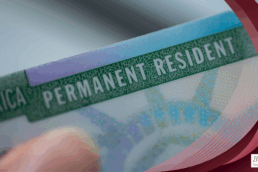 If you are a lawful resident in the U.S. through marriage to a U.S. citizen, your first green card is “conditional” for the first two years. To remove the conditionality off your permanent green card, you will need to file a Form I-751, Petition to Remove the Conditions of Residence.
If you are a lawful resident in the U.S. through marriage to a U.S. citizen, your first green card is “conditional” for the first two years. To remove the conditionality off your permanent green card, you will need to file a Form I-751, Petition to Remove the Conditions of Residence.
In most cases, Form I-751 must be signed by both you and your U.S. citizen spouse and mailed to USCIS (U.S. Citizenship and Immigration Services) within 90 days before the two-year anniversary issue date of your conditional green card.
If you divorce or your marriage is annulled before the two years have passed and you would like to continue living in the U.S., you will still need to submit Form I-751, but you will have to include a request for a waiver from the joint filing requirement.
Waivers can be based on:
- Divorce after a good-faith marriage;
- Abuse or battery by your U.S. spouse in a good-faith marriage; or
- Extreme hardship on you, the immigrant, if returned to your country of origin.
To obtain a divorce waiver, you will have to convince USCIS that there are valid reasons preventing you from filing Form I-751 jointly and that your marriage was genuine. USCIS wants to be sure that the relationship was “bona fide” and not just a way to navigate around immigration laws.
You should also prepare a written explanation of why your marriage ended. I-751 waivers are discretionary, meaning USCIS makes a decision on a case-by-case basis. If USCIS learns that you were at fault in the termination of your marriage, for example, by abandoning your spouse or committing adultery, they may deny your I-751 petition.
What happens if you haven’t yet filed for divorce or the divorce is not yet final?
If you have separated from your U.S. citizen spouse or if he or she refuses to file Form I-751 with you, you have a few options:
- You can remain married and file Form I-751 with a waiver based on “extreme hardship” or “battery or extreme cruelty” if either applies to you, or
- You can file for divorce and mail the Form I-751 with evidence that you have initiated divorce proceedings.
Typically, USCIS will accept your I-751 without evidence of the final divorce and then send you a “Request for Evidence” asking for the final divorce decree within 87 days.
Divorce proceedings can take several months or longer if contested, but 87 days might be enough time to get the final divorce degree.
Filing an I-751 with a Divorce Waiver
In order to file a Form I-751 with a waiver based on divorce, you must submit your completed and signed petition along with the following:
- Filing Fee or, if you can’t afford to pay the fee, Form I-912, Request for Fee Waiver;
- Copy of your permanent resident card (front and back sides);
- Copy of the divorce decree or annulment document that ended your marriage (if not available, evidence that the divorce proceedings are underway);
- Evidence that the marriage was genuine (click here for more information on marital bonafides); and
- Evidence regarding the circumstances surrounding the end of your marriage (if you were not at fault).
You may also want to include a personal statement or other evidence about the circumstances surrounding your divorce in order to show that it was not your fault that the marriage ended. For example, you can provide evidence of:
- No-Fault Divorce – If the divorce was due to irreconcilable differences or a mutual understanding, you should state that the divorce was a no-fault action and explain the differences that led to the end of your marriage (for example, disagreements about whether to have children, where to live, or anything else that is relevant).
- The divorce having been your ex-spouse’s fault – If you allege grounds for divorce or annulment such as adultery, abandonment, impotency, or imprisonment, you should submit a copy of the divorce or annulment petition that alleges those fault grounds or documents supporting those allegations.
You can also provide affidavits from people who knew you and your ex-spouse attesting to the fact that the divorce was the fault of your former spouse.
- Having attempted marriage counseling – If you or your ex-spouse initiated marriage counseling sessions prior to your divorce, you can provide invoices for those sessions or evidence that you tried to convince your former spouse to go to a marriage counselor. This also helps prove that the marriage was bona fide.
After You File
After filing your petition, USCIS will send you a receipt notice on Form I-797 that will extend your conditional resident status for one year. Form I-797 will serve as your green card after your conditional card expires and will allow you to continue to live and work in the U.S. and travel abroad.
Make sure to respond to all requests for evidence and appointment notices from USCIS. Most petitions to lift conditions that are filed with a waiver of the joint filing requirement are referred to a local office for an interview. When you attend your interview, bring copies of all evidence that you submitted along with your Form I-797 and be prepared to answer questions about your marriage and divorce.
If you are recently divorced or going through a divorce and have questions on filing Form I-751, please contact our office to schedule a consultation with one of our knowledgeable attorneys today!
Related Posts
October 7, 2025
DHS Plans Major Updates to Employment-Based Green Card Rules
September 25, 2025
What Is the Trump Gold Card? Requirements and Details
Ready to have Berardi on your side?
Whether you’re a business looking to hire or a professional hoping to relocate, immigration law can be complicated. But you don’t have to do it alone. Put our experience to work for you.


